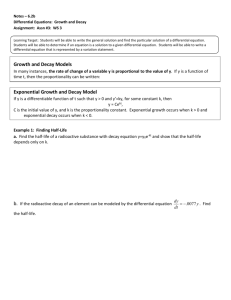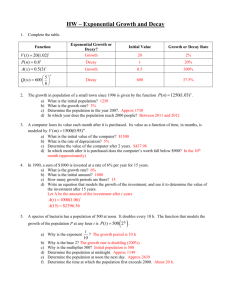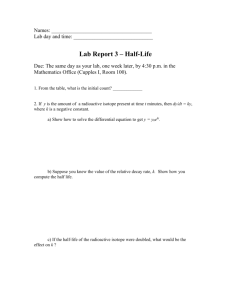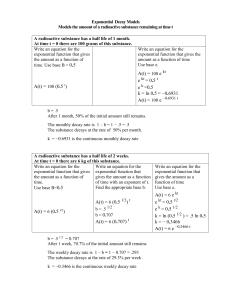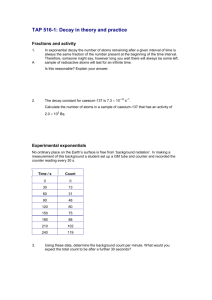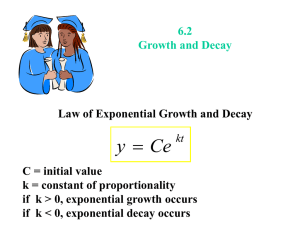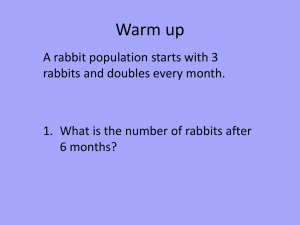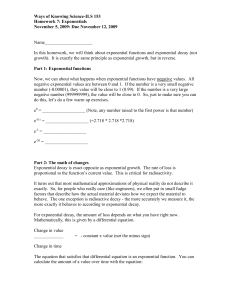Day 10 - Exponential Growth and Decay
advertisement
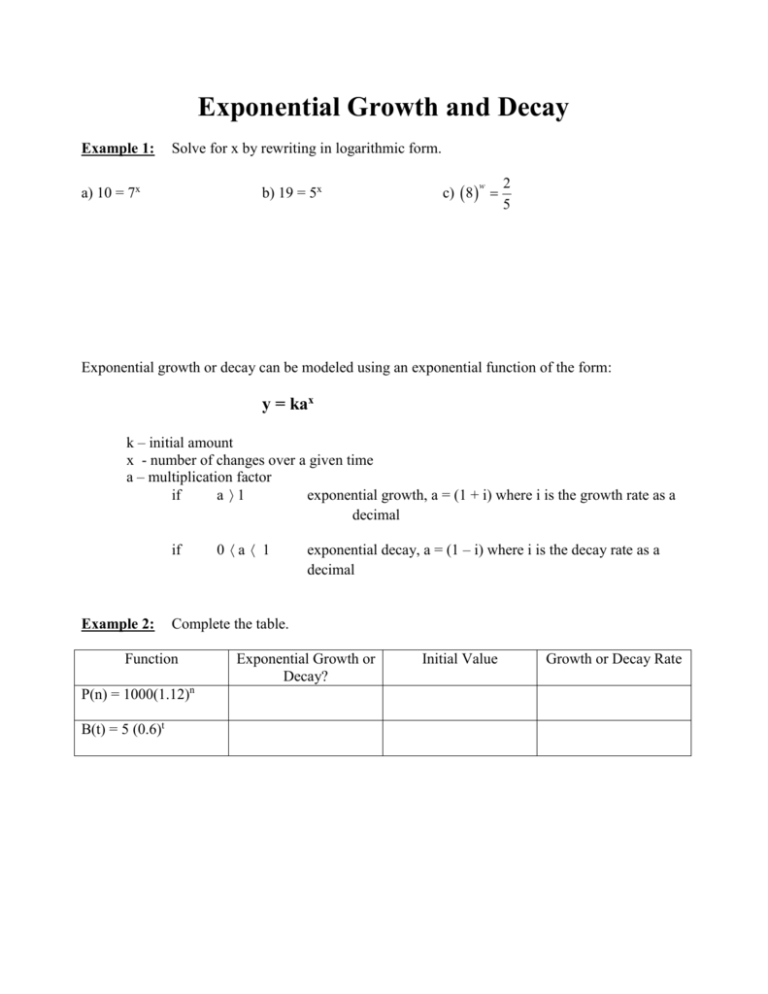
Exponential Growth and Decay Example 1: Solve for x by rewriting in logarithmic form. a) 10 = 7x b) 19 = 5x c) 8 w 2 5 Exponential growth or decay can be modeled using an exponential function of the form: y = kax k – initial amount x - number of changes over a given time a – multiplication factor if a 1 exponential growth, a = (1 + i) where i is the growth rate as a decimal if Example 2: exponential decay, a = (1 – i) where i is the decay rate as a decimal Complete the table. Function P(n) = 1000(1.12)n B(t) = 5 (0.6)t 0 a 1 Exponential Growth or Decay? Initial Value Growth or Decay Rate Example 3: The growth in population of Canada since 2001 is given by the function P(n) = 31051000 (1.01)n a) What was the population in 2001? b) What is the growth rate? c) Determine the population by the year 2011. d) In what year does the population reach 33,000,000? Example 4: Write an equation that models the situation described. Explain what each part of the equation represents. a) The population of Ontario in 1999 was about 11,514,000. At the time the annual growth rate was 1.1 % b) The price of a new car is $24,599. Its value depreciates by 30% each year. c) The hydrogen isotope tritium is radioactive, with a half-life of 12.5 years. An initial sample contains 35.2 units of radioactive tritium. HW – Exponential Growth and Decay 1. Complete the table. Function Exponential Growth or Decay? Initial Value Growth or Decay Rate V (t ) 20(1.02)t P(n) 0.8n A( x) 0.5(3) x 5 Q( w) 600 8 w 2. The growth in population of a small town since 1996 is given by the function P(n) 1250(1.03) n . a) What is the initial population? b) What is the growth rate? c) Determine the population in the year 2007. d) In which year does the population reach 2000 people? 3. A computer loses its value each month after it is purchased. Its value as a function of time, in months, is modeled by V (m) 1500(0.95) m . a) What is the initial value of the computer? b) What is the rate of depreciation? c) Determine the value of the computer after 2 years. d) In which month after it is purchased does the computer’s worth fall below $900? 4. In 1990, a sum of $1000 is invested at a rate of 6% per year for 15 years. a) What is the growth rate? b) What is the initial amount? c) How many growth periods are there? d) Write an equation that models the growth of the investment, and use it to determine the value of the investment after 15 years. 5. A species of bacteria has a population of 500 at noon. It doubles every 10 h. The function that models t the growth of the population P at any hour t is P(t ) 500 210 . a) Why is the exponent b) c) d) e) f) 6. t ? 10 Why is the base 2? Why is the multiplier 500? Determine the population at midnight. Determine the population at noon the next day. Determine the time at which the population first exceeds 2000. Which of these functions describe exponential decay? Explain. a) g ( x) 4(3) x b) h( x) 0.8(1.2) x c) j ( x) 3(0.8)2 x d) k ( x ) x 1 0.9 2 3 7. A town with a population of 12 000 has been growing at an average rate of 2.5% for the last 10 years. Suppose this growth rate will be maintained in the future. The function that models the town’s growth is P(n) 12(1.025n ) where P(n) represents the population (in thousands) and n is the number of years from now. a) Determine the population of the town in 10 years. b) Determine the number of years until the population doubles. c) Used this equation to determine the number of years ago that the population was 8000. Answer to the nearest year. d) What are the domain and range of the function? 8. A student records the internal temperature of a hot sandwich that has been left to cool on a kitchen t counter. The room temperature is 19C. An equation that models this situation is T (t ) 63(0.5)10 19 where T is the temperature in degrees Celsius and t is the time in minutes. a) What was the temperature of the sandwich when she began to record its temperature? b) Determine the temperature, to the nearest degree, of the sandwich after 20 min. c) How much time did it take for the sandwich to reach an internal temperature of 30C? 9. In each case, write an equation that models the situation described. Explain what each part of each equation represents. a) the percent of colour left if blue jeans lose 1% of their colour every time they are washed b) the population if a town had 2500 residents in 1990 and grew at a rate of 0.5% each year after that for t years c) the population of a colony if a sigle bacterium takes 1 day to divide into two; the population is P after t days 10. A population of yeast cells can double in as little as 1 hour. Assume an initial population of 80 cells. a) What is the growth rate, in percent per hour, of this colony of yeast cells? b) Write an equation that can be used to determine the population of cells at t hours. c) Use your equation to determine the population after 6 hours. d) Use your equation to determine the population after 90 minutes. e) Approximately how many hours would it take for the population to reach 1 million cells? f) What are the domain and range for this situation? 11. A collector’s hockey card is purchased in 1990 for $5. The value increases by 6% every year. a) Write an equation that models the value of the card, given the number of years since 1990. b) Determine the increase in value of the card in the 4th year after it was purchased (from year 3 to year 4). c) Determine the increase in value of the card in the 20th year after it was purchased. 12. Light intensity in a lake falls by 9% per metre of depth relative to the surface. a) Write an equation that models the intensity of light per metre of depth. Assume that the intensity is 100% at the surface. b) Determine the intensity of light at a depth of 7.5 m. 13. The hydrogen isotope tritium is radioactive, with a half-life of 12.5 years. A sample contains 35.2 units of radioactive tritium. What amount would remain after 25 years? 14. An isotope of sodium, Na-24, has a half-life of 15 h. If a sample contains 3.6 units of Na-24, how much would remain after each time has elapsed? a) 30 h b) 4 h c) 5 days 15. A town has a population of 8400 in 1990. Fifteen years later, its population grew to 12 500. Determine the average annual growth rate of this town’s population. (Thinking question).


